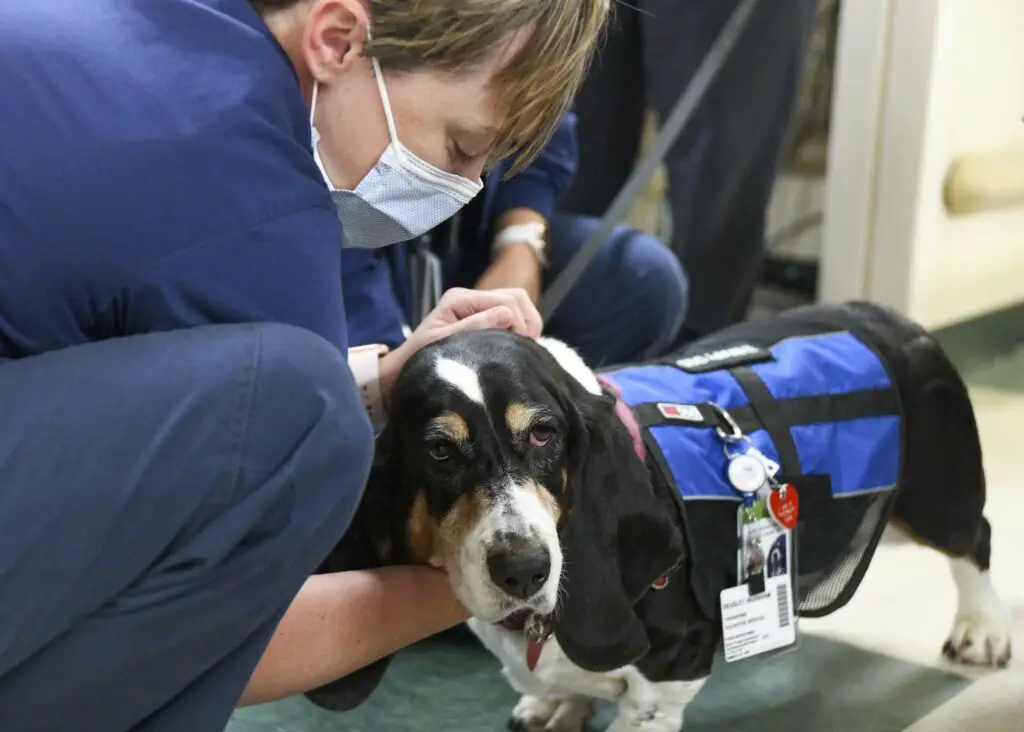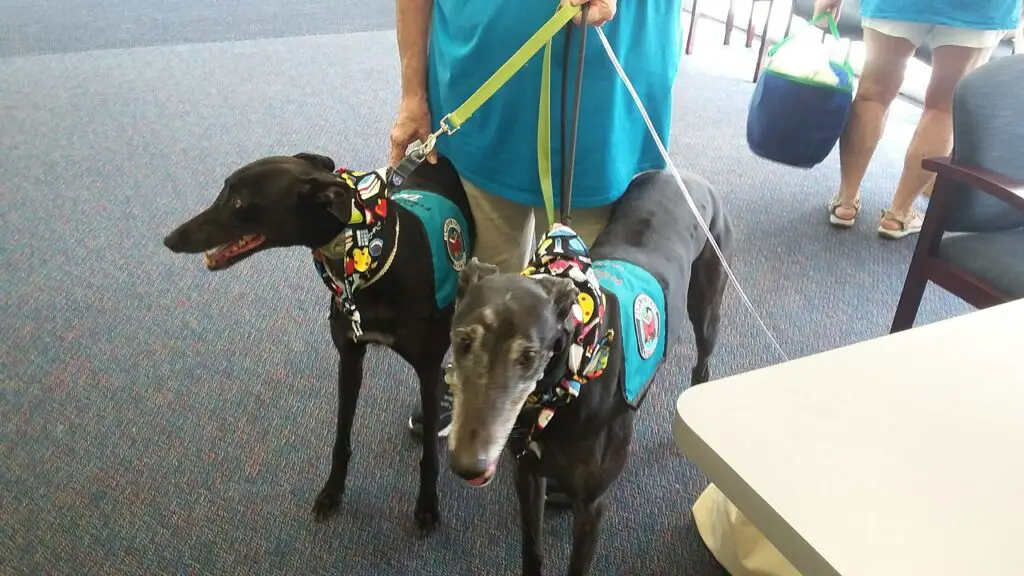It’s no secret that dogs have a special ability to sense and respond to their owners’ emotional states.
Whether we’re happy, sad, or anxious, our furry friends seem to know exactly how we’re feeling without us even saying a word.
But did you know that dogs have been trained to detect and even help alleviate symptoms of depression?
It may sound like something out of science fiction, but recent studies have shown that dogs can actually pick up on the subtle changes in our behavior and body chemistry when we’re feeling down.
So how do they do it? What clues do they look for? And most importantly, can this canine intuition be harnessed as an effective treatment for mental health disorders?
Key Takeaway
| Topic | Key Takeaway |
|---|---|
| Dogs Sensing Emotions | Dogs can sense human emotions, including anxiety and depression, due to their extraordinary sense of smell, keen observational skills, and high emotional intelligence. |
| Detecting Depression in Humans | Dogs can detect depression through their sense of smell (detecting changes in body chemistry), reading human body language, and their emotional intelligence. |
| Therapy Dogs for Depression | Therapy dogs are selected, trained, and paired with individuals to provide comfort, companionship, and emotional support for those struggling with depression. |
| Dogs Sensing Sadness | Therapy dogs can detect when a person is sad by picking up on biochemical changes in the body and observing changes in behavior, tone of voice, or daily routines. |
| Conclusion | Dogs have the potential to be invaluable companions for those struggling with depression, providing comfort and support alongside professional mental health treatment. |
Can My Dog Feel My Anxiety And Depression?

Yes, dogs are quite sensitive to human emotions, including anxiety and depression.
This is partly because of their extraordinary sense of smell, which allows them to pick up on subtle changes in our bodies that might correlate with our emotional state.
More than just olfactory perception, dogs have evolved to be keen observers of human behavior. Their canine intuition enables them to notice even minor shifts in our actions, tones, or habits.
Furthermore, dogs exhibit a fascinating level of emotional intelligence. A dog’s empathy allows them to understand our emotions, and they often respond in ways that seem incredibly in tune with our emotional needs.
Have you ever noticed your dog approaching you more frequently or acting more affectionately when you’re upset? This is not a coincidence; it’s an example of a dog’s emotional intelligence at work.
This capacity of dogs to sense human emotions, particularly negative ones such as anxiety and depression, has implications for the type of relationship that can form between a person struggling with mental health issues and their dog.
The bond – the human-dog bond – that forms can be a source of significant emotional support.
How Do Dogs Detect Depression?

Dogs can detect depression in humans due to their extraordinary sense of smell, keen observational skills, high emotional intelligence, and intuitive abilities.
Dogs have been known as ‘man’s best friend’ for centuries. Part of the reason for this is their incredible ability to understand and empathize with human emotions.
It’s not just a feeling either; science has shown that dogs have an astounding capability to pick up on human emotions, including conditions like depression.
But how exactly do dogs detect depression?
- Extraordinary Sense of Smell: Dogs’ sense of smell is between 10,000 to 100,000 times more sensitive than ours. With this, they can detect subtle changes in human body chemistry. When we’re depressed, our body may release different pheromones or have changes in hormones such as cortisol, which dogs could potentially detect.
- Reading Human Body Language: Dogs have evolved alongside humans for thousands of years. During this time, they’ve become expert observers of human behavior. They can pick up on subtle cues in our body language that signals when we’re upset, anxious, or depressed. Changes in our daily routine, reduced activity, or unusual behavior, which often accompany depression, are easily noticed by dogs.
- Emotional Intelligence: Canine emotional intelligence refers to a dog’s ability to perceive, understand, and react to human emotions. Dogs can often mirror their owner’s emotions and adapt their behavior accordingly. If a dog’s owner is depressed, the dog may become quieter and spend more time close to their owner, providing comfort.
- Intuitive Abilities: Dogs seem to have an intuitive sense of detecting when something isn’t right with their owners. Though it’s not fully understood scientifically, many dog owners can attest to their dogs acting differently or showing signs of concern when they’re emotionally distressed.
What Do Therapy Dogs Do For Depression?
Step 1: Selection of Therapy Dogs
Therapy dogs for depression are often chosen based on their temperament. The ideal therapy dog is generally calm, gentle, patient, and enjoys human interaction.
Some organizations and professionals specifically train therapy dogs to work in various environments, including private homes, hospitals, schools, and mental health institutions.
Step 2: Training the Therapy Dog
Once a dog is selected, it is trained to become a therapy dog. This training ensures the dog is obedient, well-mannered, and able to handle a variety of environments. They’re also trained to recognize signs of emotional distress, providing comfort through their presence and touch.
Step 3: Pairing Therapy Dogs with Individuals
After a therapy dog is fully trained, they are matched with an individual who needs assistance. This could be someone suffering from depression or another mental health disorder. The aim is to create a strong, beneficial bond between the dog and the individual.
Step 4: Regular Interaction
The therapy dog interacts with their human partner on a regular basis. This could involve a variety of activities, such as petting, hugging, playing fetch, or simply being in the same room together. These interactions can increase the level of oxytocin (the “love hormone”) in the human body, which can help decrease feelings of anxiety and depression.
Step 5: Providing Comfort and Companionship
The primary role of a therapy dog for depression is to provide comfort and companionship. Their presence can have a calming effect, which can be particularly helpful during periods of increased stress or anxiety.
Step 6: Encouraging Routine and Responsibility
Therapy dogs also help create a daily routine as they require feeding, exercise, and general care. This responsibility can provide a sense of purpose for individuals with depression. Plus, the physical activity required to care for a dog can help boost mood and energy levels.
Step 7: Facilitating Social Interaction
Therapy dogs can also facilitate social interaction. They can be a conversation starters, which could help individuals with depression who may feel isolated or have difficulty initiating conversations. Engaging with others can also improve mood and outlook.
Step 8: Review and Adaptation
Finally, the effectiveness of the therapy dog in managing the individual’s depression is continuously monitored. Adjustments are made as needed, such as additional training for the dog, to ensure the relationship remains beneficial.
Do Therapy Dogs Know When You Are Sad?
Yes, therapy dogs do have a unique ability to detect when you’re sad.
Their extraordinarily acute sense of smell allows them to pick up on biochemical changes in our bodies, such as an increase in cortisol, a hormone that is often elevated when we’re stressed or sad.
In addition to this, dogs are exceptional observers of human behavior. They can perceive subtle changes in our body language, tone of voice, or daily routines, which often alter when we’re feeling low.
Moreover, therapy dogs, thanks to their specific training and high level of emotional intelligence, are not just capable of detecting these emotional shifts but also respond in ways that provide comfort and support.
However, it’s important to note that while dogs can sense our basic emotional states, they don’t fully understand the complexities of human emotions.
In Conclusion
In conclusion, dogs have the ability to detect changes in our behavior and emotions, including depression.
They are sensitive creatures who often provide comfort and support to their owners during difficult times.
If you are thinking of getting a dog as a companion for your mental health, it is important to understand that they can play an important role in your recovery journey.
However, it is essential to research and choose the right breed that will suit your needs best. It is also crucial to seek professional help if needed alongside the support of a furry friend.
With love, patience, and proper care, dogs have the potential to be invaluable companions for those struggling with depression.





Leave a Reply